As the Ethereum Shanghai upgrade draws near, there's been a growing interest in the LSD (Liquid Staking Derivatives) sector. EigenLayer, which recently released a white paper, has been the center of attention. 『 Restaking 』 is the core concept of EigenLayer. When I first learned about EigenLayer, Restaking was the biggest issue I had trouble understanding. However, after conducting research, I've gained some preliminary understanding. In this article, I hope to help readers who share the same doubts as me to understand better the origin of Restaking and the problems it aims to solve.
Evolution of Trust in Blockchain
Before we dive into what Restaking is, let's first review the practical meaning and evolution of trust in Blockchain.
Bitcoin and Decentralized Trust
Bitcoin, proposed by Satoshi Nakamoto, is a decentralized trust structure. This trust comes from the fact that each miner has their own ledger. Even if a malicious miner tries to modify their ledger, it will still be rejected by other honest miners.
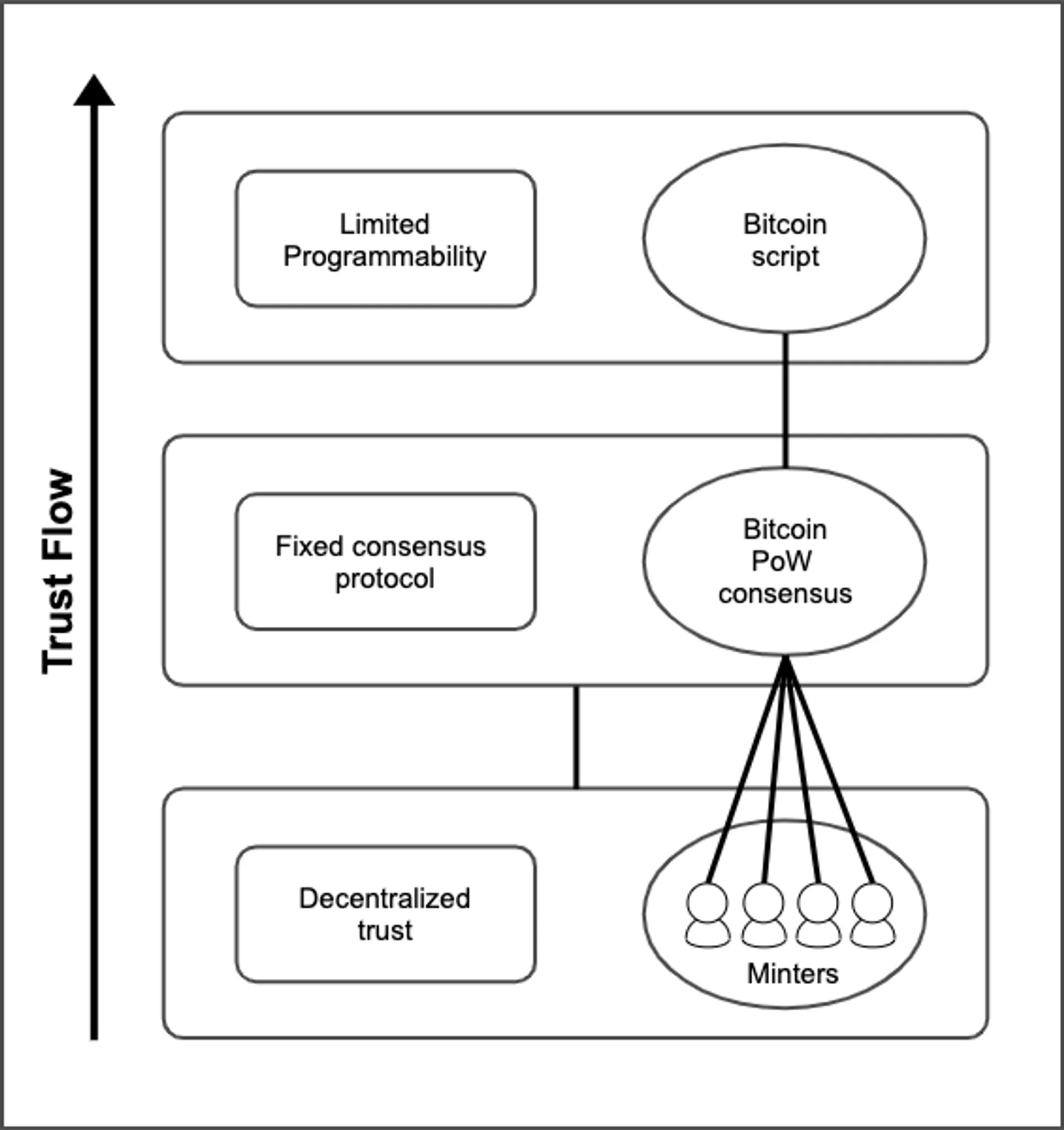
The above diagram simplifies the Bitcoin architecture into three layers. The bottom layer represents miners who operate the entire Bitcoin network. The middle layer represents miners who follow a set of PoW (Proof of Work) rules to generate the next block. The top layer (Limited Programmability) refers to the application services that run on this network, mainly for peer-to-peer transfers. We trust that the peer-to-peer transfer service at the top layer is correct mainly because we trust that the miners at the bottom all follow the same rules (PoW) to generate blocks (modify ledgers), and there are no malicious modifications in the middle layer (if there are, they will not be recognized by other miners). This is a bottom-up trust process.
In the early days, if one wanted to establish another decentralized application service, they would have to replicate the same architecture. In order to incentivize miners to operate the decentralized network in a specific way, miners would follow certain rules together, ultimately allowing decentralized application services to run on this decentralized network. As shown in the diagram below, this is why early new decentralized services corresponded to a new chain.
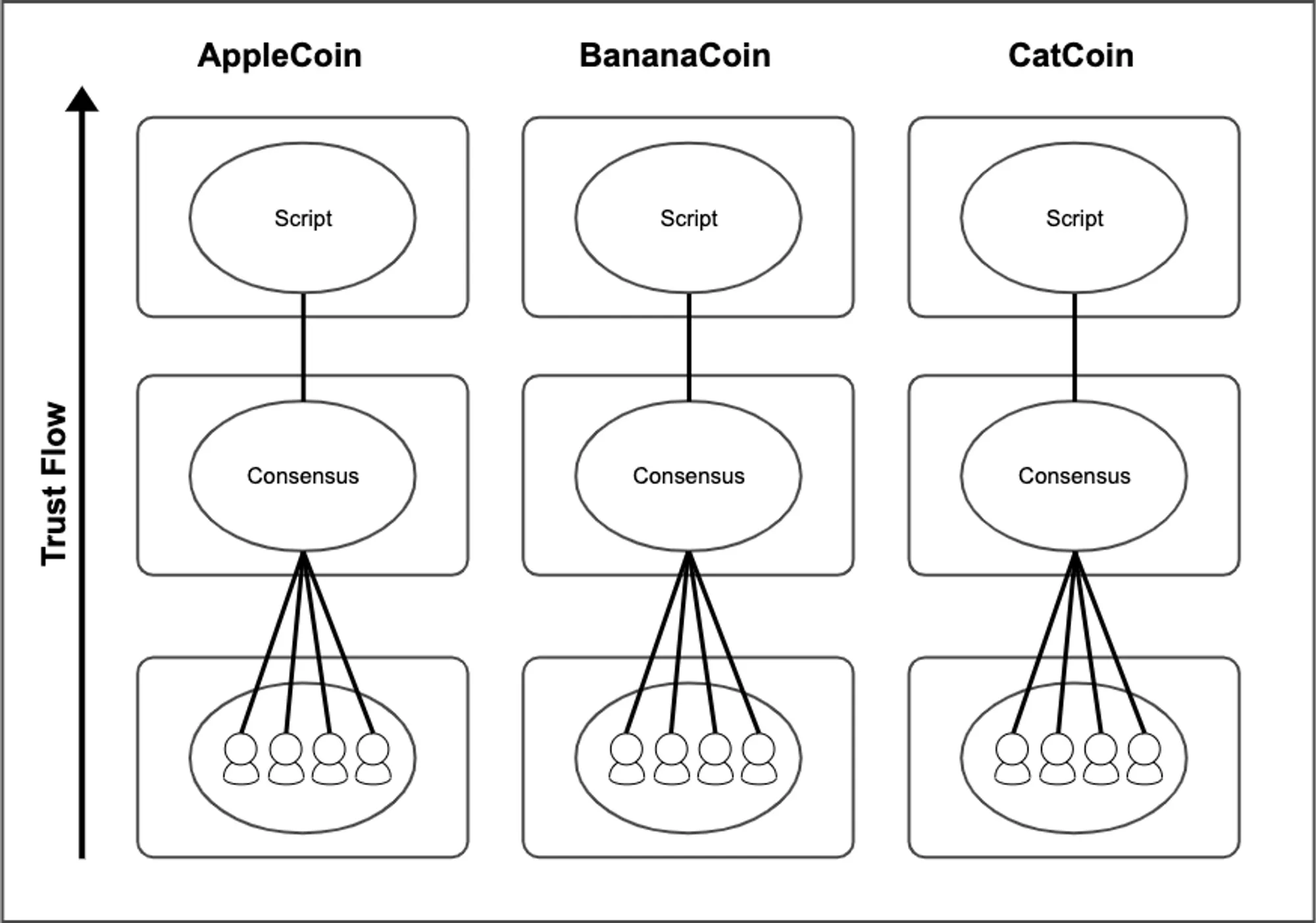
Modular Trust in Ethereum
Until the emergence of Ethereum, there were few innovations in the trust structure. The biggest difference between Ethereum and Bitcoin's trust structure is that the top layer is no longer limited to a script language. Instead, it is a Turing-complete program executor: EVM (Ethereum Virtual Machine). With EVM, anyone can create their own decentralized services (DApps) on the Ethereum network, such as AAVE, ENS, or Uniswap. These decentralized services are executed through EVM, and the correctness of EVM execution results is ensured by the nodes in the lower layer (following the PoS consensus rules). Through this mechanism, people who want to build different DApps no longer need to establish another decentralized network to gain trust, but can directly use Ethereum's trust network, which means that trust is modularized. This modularized trust structure significantly reduces the threshold for DApp innovation because there is no need to build another decentralized network for a specific DApp.
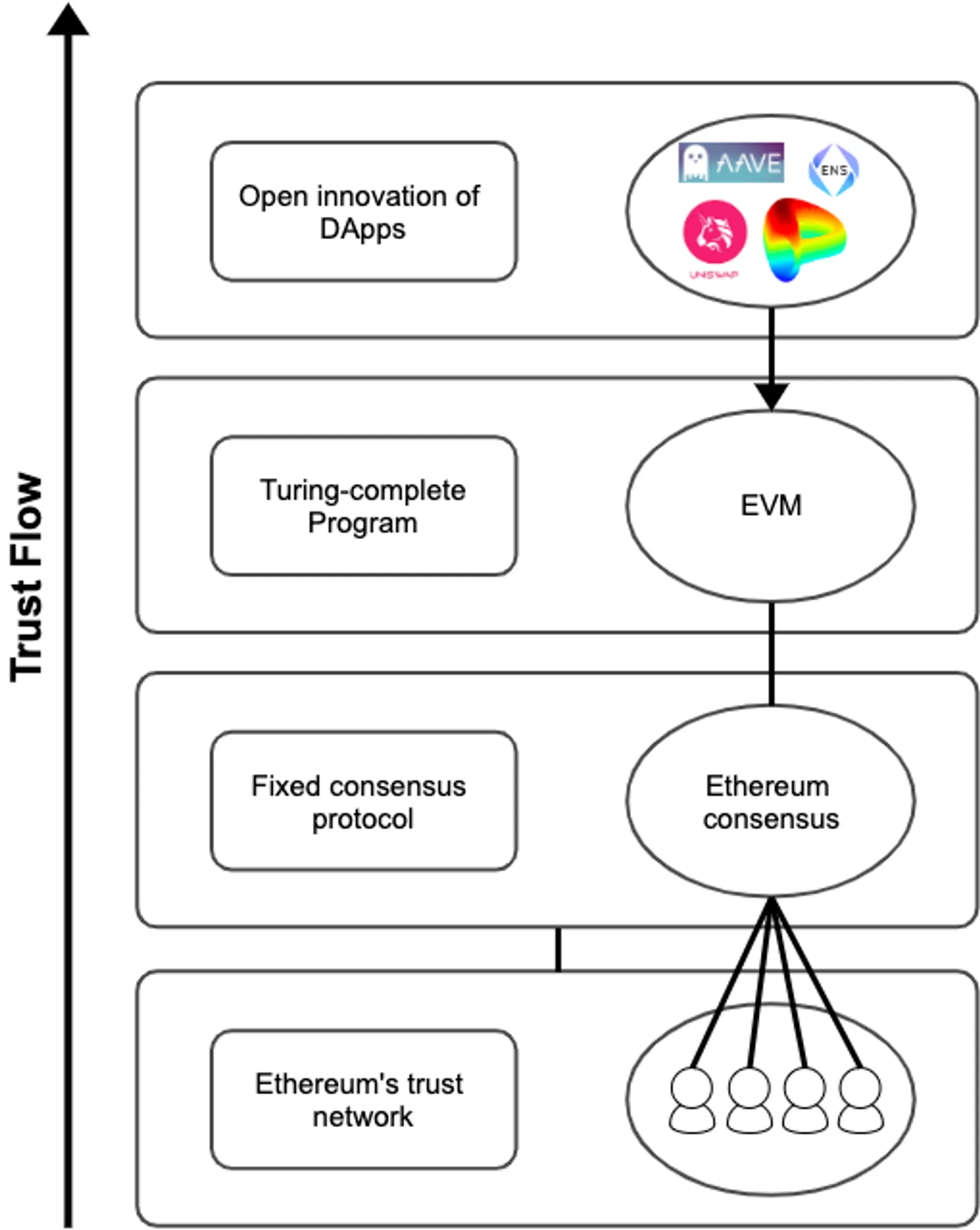
Barries to open innovation: Middlewares
However, there are still some issues with this modularized trust. The main reason is that Ethereum can only provide block-making-level trust. Block-making trust mainly refers to two things:
-
Transaction ordering
-
Transaction execution
If services outside of on-chain transactions are required, trust cannot be obtained from the Ethereum network (because Ethereum can only guarantee that transactions will be executed correctly according to the contract code). Usually, such services still need to establish another (decentralized) network of trust. Most of these types of services are also part of a DApp system, which are collectively referred to as Middlewares.
To ensure the security of Middlewares, a mechanism needs to be designed to ensure the correctness of data (to ensure that data is not maliciously tampered with). The most common situation is to design a high-yield economic model that encourages others to pledge to ensure the security of the service (e.g., Chainlink Staking). This makes the main cost of Middlewares to maintain a high APR an economical cost rather than an operational cost. Any service that has its own distributed verification mechanism for verification is called Actively Validated Services (AVS). The above use of token economic mechanisms to ensure security is just one method. Other methods, such as optimistic verification used by Nomad cross-chain bridges, and Wormhole/Axie cross-chain bridges that ensure security through trusting a few specific authorized relayers, are all trust issues that EigenLayer hopes to solve through Restaking.
Usually, a large DApp will not only run its own services but also need to integrate different Middlewares (e.g., Oracle, Bridge, etc.). In the case where each Middlewares has its own AVS to ensure the credibility of the data, the situation is as shown in the following diagram.
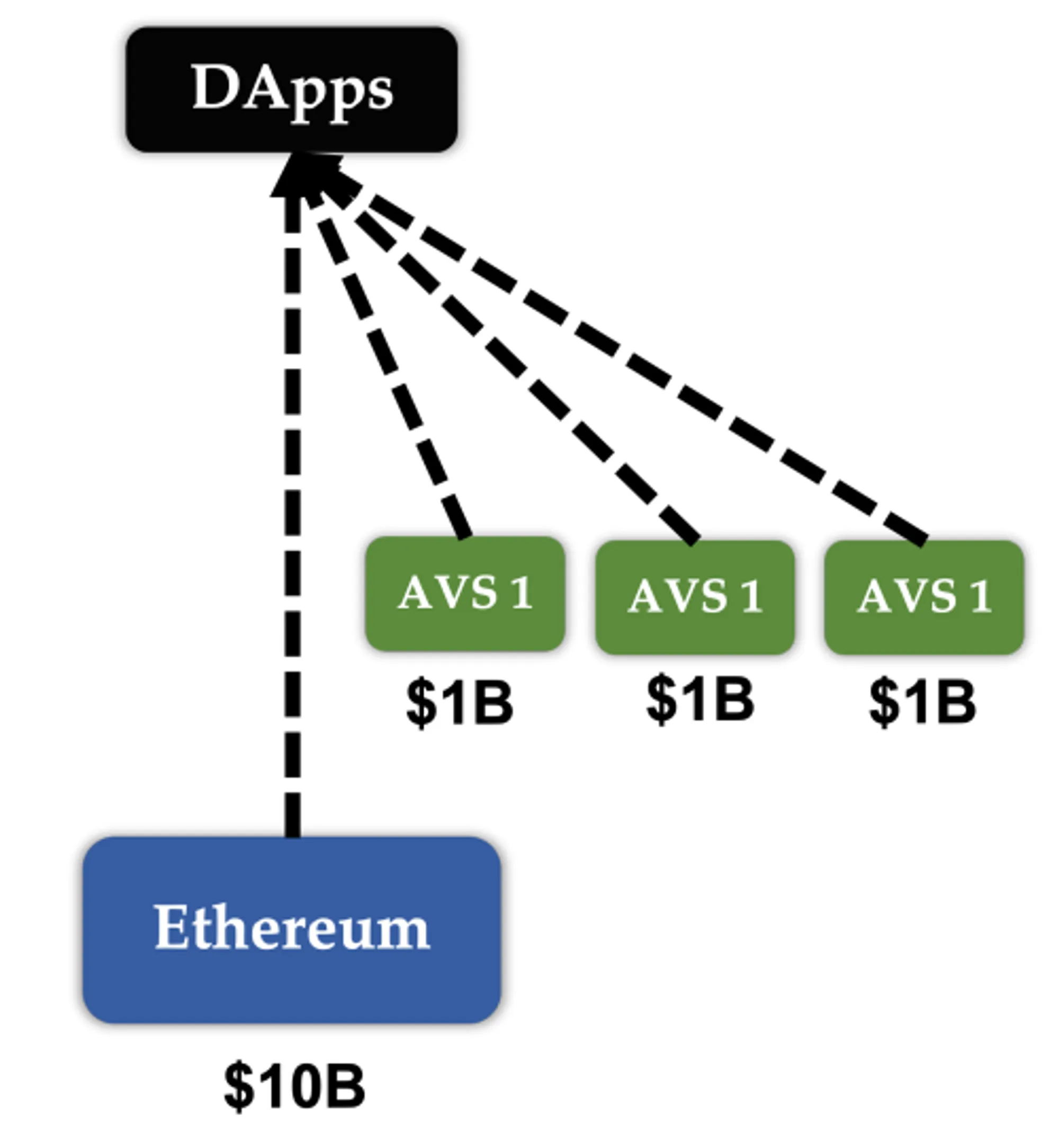
The Problems for Current DAapp
Currently, there are some issues with the DApp architecture:
-
AVS cannot inherit trust from existing ETH. Ethereum itself already has a trust mechanism in place, and Middlewares cannot obtain trust (security) from this mechanism and need to create another trust network (AVS).
-
The threshold for building a new full-trust network (AVS) from scratch is very high.
-
Each AVS has its own pool, and Stakers need to pay additional fees to these pools besides paying Ethereum transaction fees. Using EigenLayer, there is no need to pay additional fees to these pools, or in other words, transaction fees are transferred to Ethereum validators. Under the original architecture, Ethereum validators cannot obtain these fees. This problem is referred to as Ethereum's Value Leakage.
-
AVS will become the weakest link in the security of the DApp system. Because compared to disrupting the Ethereum network, the cost of disrupting AVS will be lower (using the example in the above diagram: Ethereum network: 10B, other AVS: 1B).
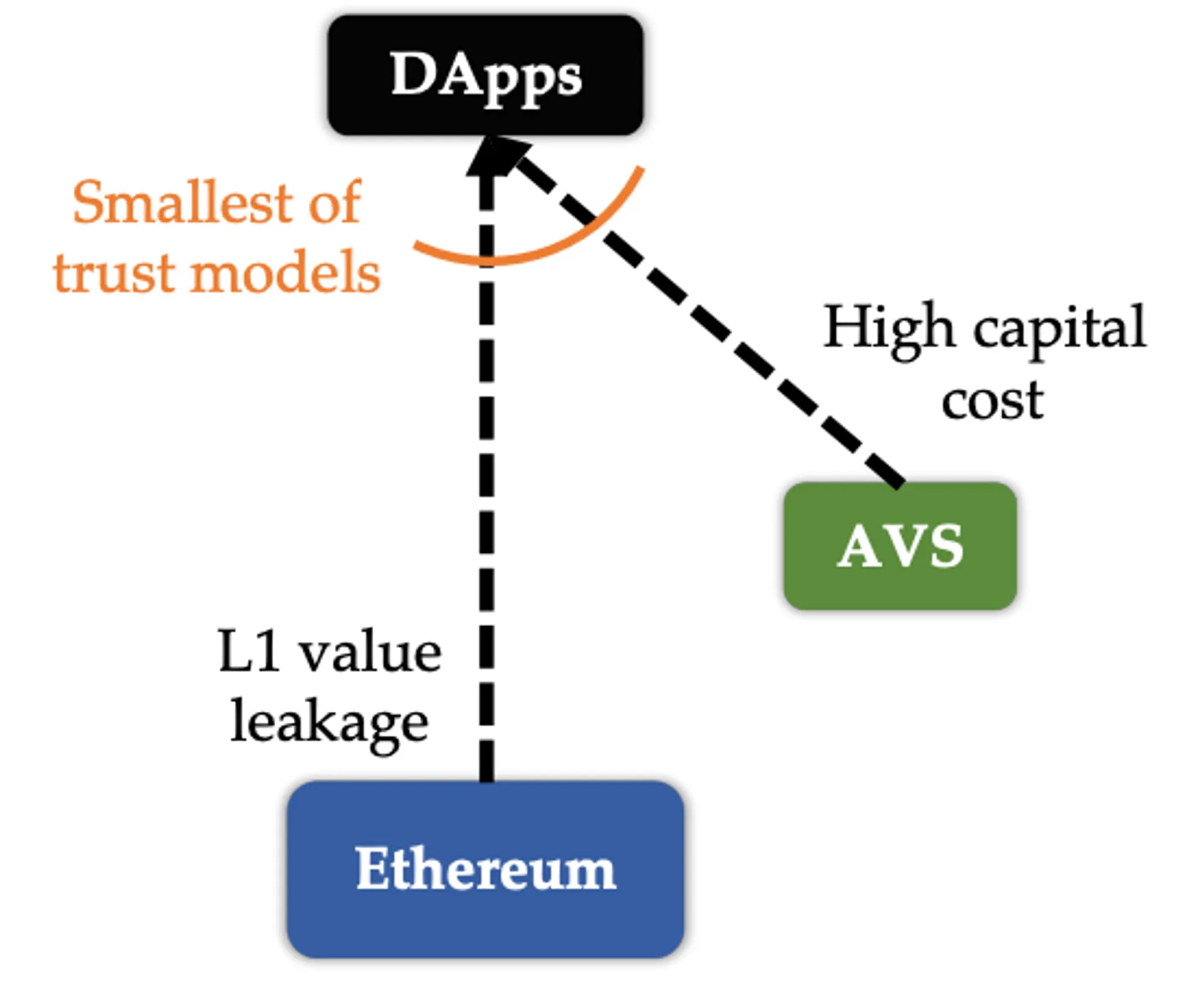
EigenLayer Solution
EigenLayer proposes two solutions:
-
Pooled Security via Restaking
-
Free-market governance
Pooled Security via Restaking
Allow the same funds to be staked in different trust (decentralized) networks to secure the data accuracy of different trust networks.
In practice, the staked funds are those of Ethereum network validators, which are also used by EigenLayer to stake in other Middlewares' trust networks.
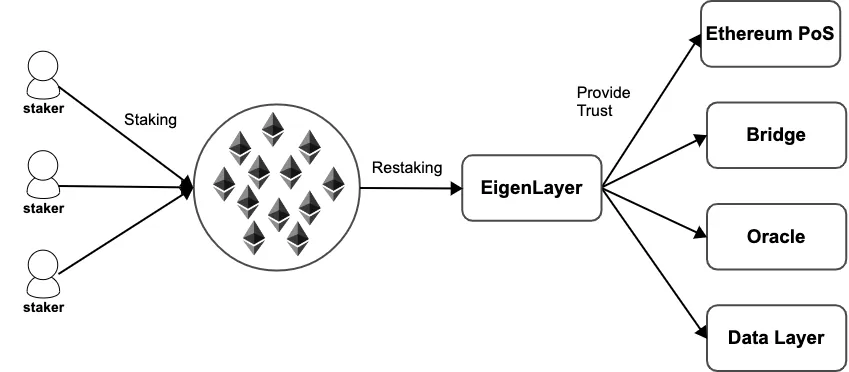
For Stakers
-
By staking the same funds in different trust networks and serving as validators for different networks, validators can earn additional validation rewards. However, if a validator engages in malicious behavior that harms the AVS, the staked capital will be punished and reduced (Shashing), which is the risk that validators must bear to earn additional rewards.
-
The cost of maintaining the security of DApps is lower because there is no need to prepare two sets of funds to ensure the security of both Ethereum and Middlewares.
For Middlewares
-
The threshold for establishing a trust network is significantly lowered. It is possible to inherit part or all of the trust (funds) from the Ethereum network, without the need to create a new trust network from scratch.
-
Enhancing the security of AVS. Because everyone can share the trust brought by the same funds. In the original structure shown in the diagram, each AVS can only provide 1B worth of trust, but by switching to the EigenLayer Restaking architecture, each AVS inherits the overall 13B worth of trust, greatly enhancing security.
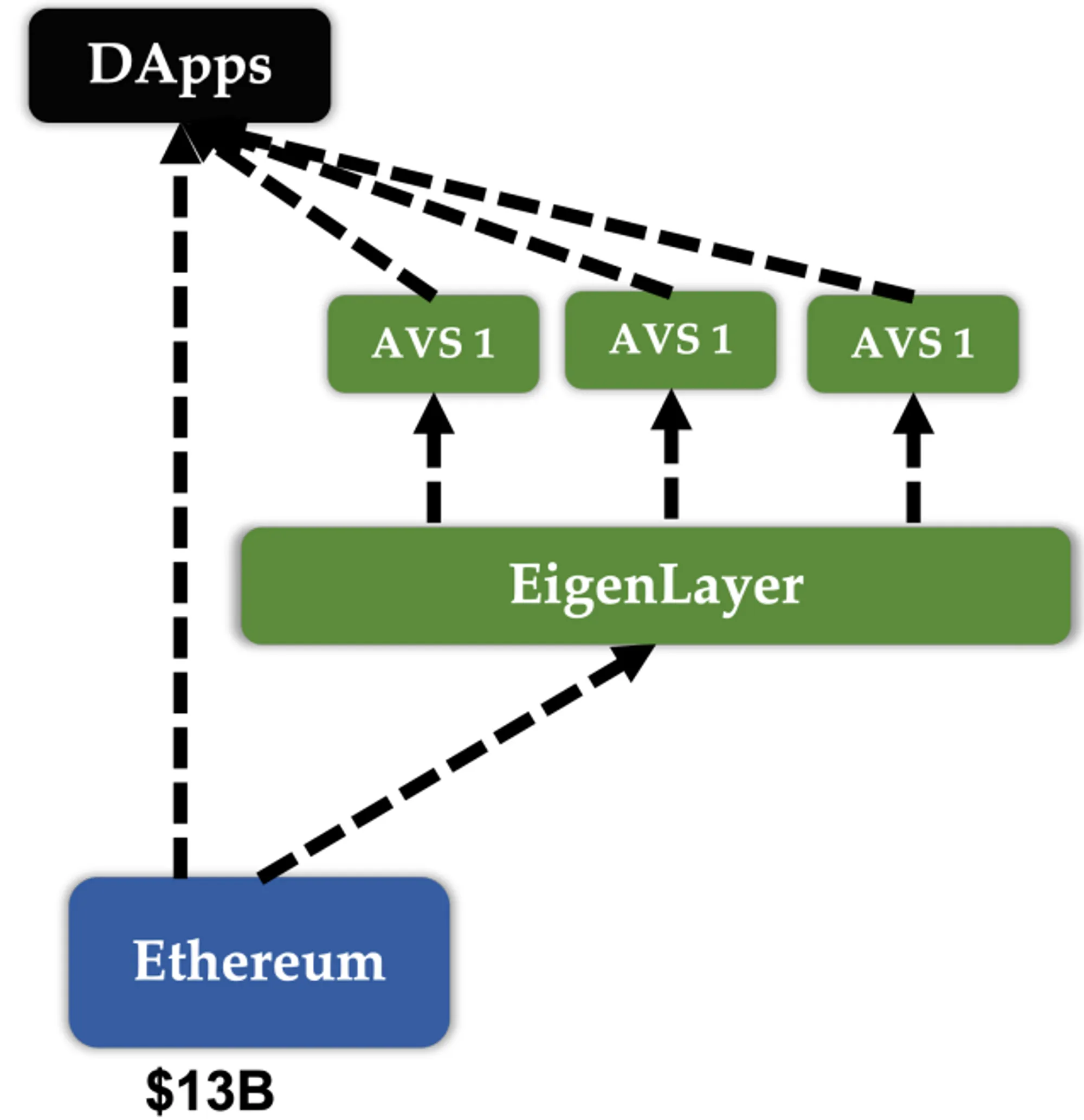
Free-market governance
Basically, it can be divided into two blocks: Staker (left) and AVS (right). Stakers can freely choose which AVS they want to participate in staking and receive rewards from. Each AVS can decide which rewards to offer to the Stakers who participate in staking, according to their own needs. This creates a free market for trading between Stakers and AVS.
For Stakers, the marginal cost of participating in staking with an additional AVS is very low. They only need to use the same capital to obtain additional rewards, without requiring additional capital. In theory, the more AVS that they participate in staking with, the higher their potential profit. Although participating in staking with other AVS does not require additional costs, they still need to bear corresponding risks. If, due to uncontrollable factors or malicious behavior harmful to AVS during the staking process, the staked funds will be reduced due to punishment (Slashing). For Stakers, as long as the total reward is greater than the total risk, they should stake more AVS as much as possible.
For AVS (in this case, Ethereum PoS is regarded as a type of AVS), in addition to being able to decide on the reward method themselves, they can also set conditions and restrictions for Stakers. Only Stakers who meet certain qualifications can stake and receive rewards on that AVS. For example, a certain AVS may require that the number of AVS staked by the Staker be less than a specific amount before they can stake on that AVS (in order to reduce the risk of operator collusion caused by staking too many AVS, which will be explained further in the article).
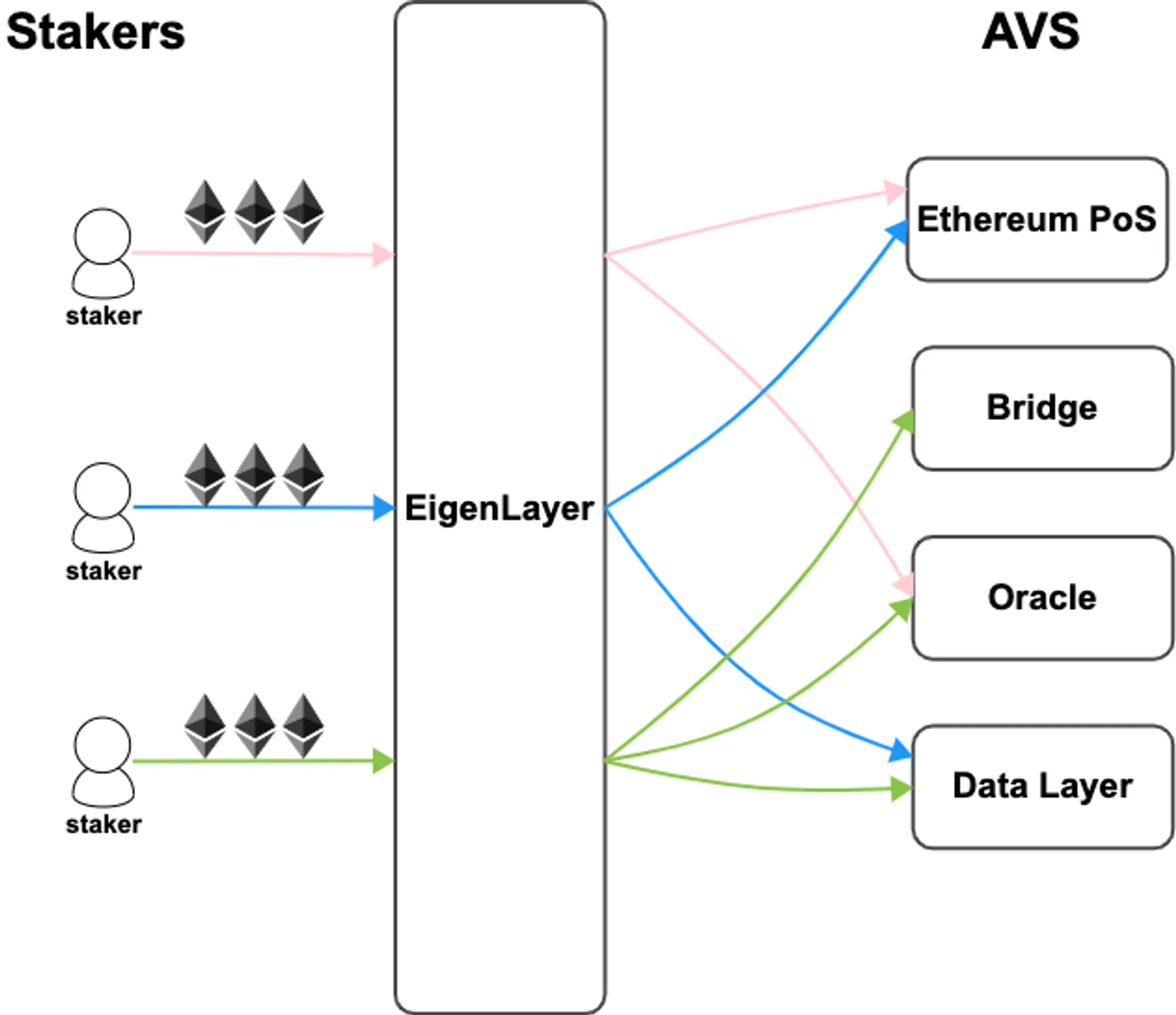
Restaking vs Merge Mining
The concept of Restaking is similar to early Merge Mining. The concept of Merge Mining is that, in the early days of PoW, the same mining machine is used to serve as a miner for different PoW networks, using the same computing power to obtain mining fees from different networks.
Merge Mining has a significant drawback in that it cannot effectively punish malicious miners. For example, a miner mines both Bitcoin and AppleCoin (generating blocks) at the same time. The miner intentionally engages in malicious behavior on AppleCoin to try to profit, but is later discovered and not recognized by other miners on the AppleCoin network, resulting in failure. The actual loss to the miner is not significant, as the malicious behavior on AppleCoin does not affect the miner's earnings on other PoW networks (Bitcoin's price is not directly affected), and the miner's mining machine can still continue to mine on other PoW networks to earn profits. The miner only loses the mining fee originally earned on AppleCoin and the electricity cost incurred for mining AppleCoin, without any additional losses.
When Ethereum transitions from PoW to PoS, if validators engage in wrongdoing, the ETH they staked will be punished and reduced. This is also the case for other AVS, where bad behavior will reduce the staked funds. This effectively reduces malicious behavior by validators. If the rules of other AVS can be written into smart contracts, then slashing (effective punishment) can be achieved. This is the main difference between Restaking and Merge Mining, and also the main reason why the Restaking system can operate.
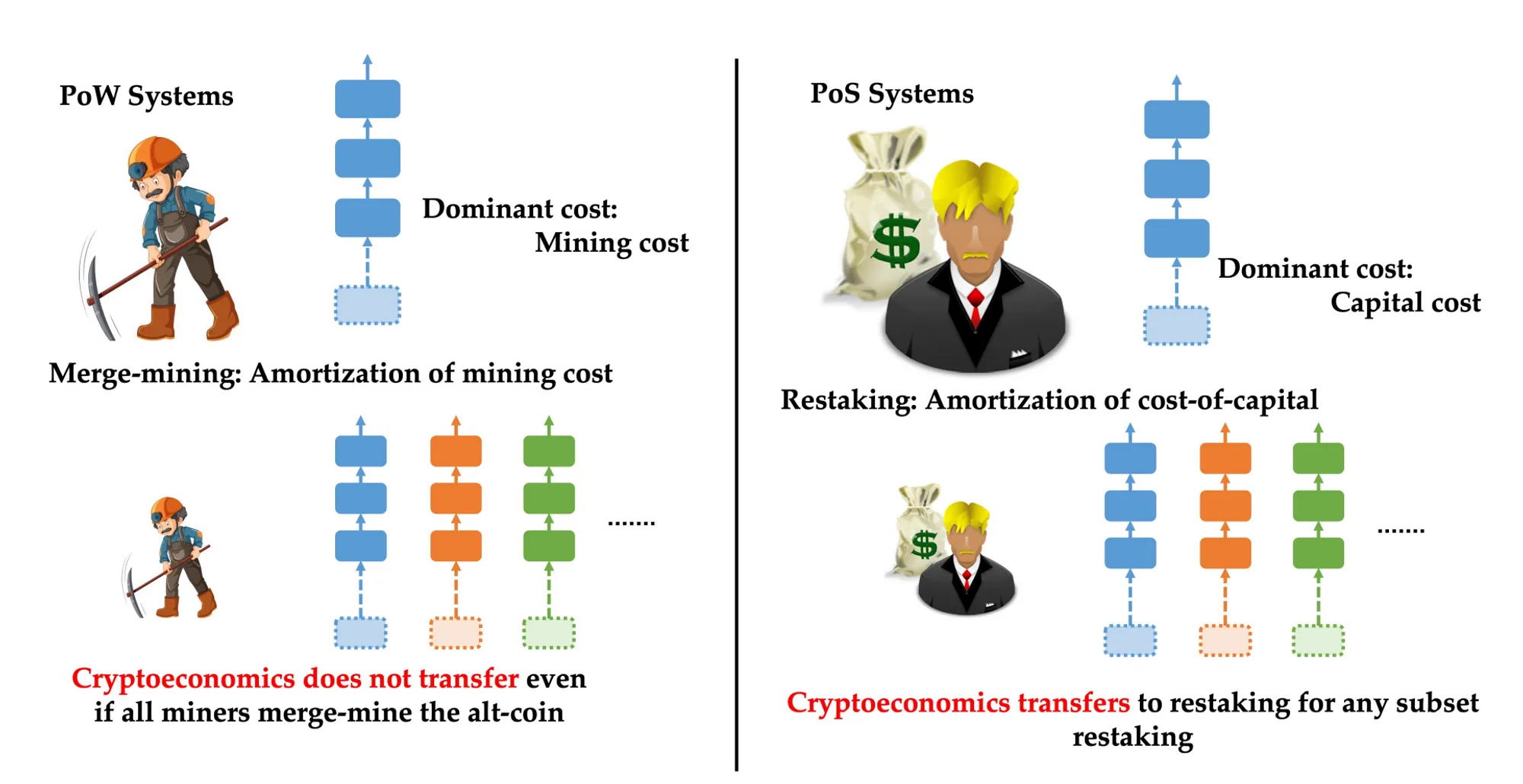
Risk
The Restaking proposed by EigenLayer does solve the above-mentioned problems, but it also brings some new ones. The EigenLayer whitepaper lists two potential risks.
-
Operator collusion
-
Unintended slashing
Operator collusion
For a Staker, staking with all AVS is the most profitable strategy, but this may lead to a situation where All AVS TVL > Cryptoeconomic Security.
Assuming that a Staker stakes a total of 8M, but participates in staking with 5 AVS with a TVL of 2M each. This situation may lead to the Staker collaborating with other Stakers to attack all AVS in order to obtain greater benefits. The concept is similar to gambling in a casino, using the same bet to place bets on multiple different games. Although there is a chance of losing all the bets, there is also a chance of winning a higher prize than the bet. This means that if the attacker succeeds in the attack, they can also obtain funds that are more than the staking cost.
All AVS TVL (2M * 5 = 10M) > Cryptoeconomic Security(8M)
EigenLayer's proposed solution is as follows:
-
AVS can set their own limiting conditions to reduce the profitability of attacks. The purpose is to reduce the profit that attackers can obtain through attacks. For example, during the Slashing period of Bridge Middleware, an upper limit on the total amount of transmission can be specified.
-
Propose a monitoring system to track the AVS in which the Staker participates, in order to limit the number of AVS that the Staker can participate in.
Unintended Slashing
This refers to situations where the staked capital is slashed due to factors that are not intentionally malicious, but rather caused by other unpredictable factors (e.g., node misconfiguration). The proposed solution here is that EigenLayer will establish a committee that can vote on whether to cancel the slashing in specific situations. The members of the committee will be individuals with high reputations in the Ethereum and EigenLayer communities. This approach serves as a short-term solution and transitional arrangement until each AVS is integrated into EigenLayer and reaches maturity.
TLDR
-
Ethereum has proposed a new modular trust innovation, which allows for the development of DApps without the need to create a new decentralized network. Developers can use the trust provided by the Ethereum network directly.
-
Ethereum only provides trust at the block generation level, and Middlewares cannot use Ethereum's trust mechanism to build broader decentralized services. Middlewares still need to create their own trust network (AVS), with the main cost being the economic model for maintaining network security.
-
EigenLayer is a platform that aims to explore the Liquid Staking Derivatives sector and provide more secure and reliable decentralized services. Its core concept is Restaking, which allows the same capital to be staked in different trust networks to ensure the security of different networks.
-
Pooled Security via Restaking allows stakers to earn more rewards while reducing the cost of maintaining DApp security. Through Restaking, stakers can stake the same capital in different trust networks and act as validators for different networks to earn rewards. Restaking can also significantly lower the threshold for building trust networks for Middlewares, allowing them to inherit some or all of Ethereum's trust (capital).
-
Free-market governance establishes an open market mechanism, where stakers can choose who to stake based on returns and risks. Middlewares can restrict stakers based on their needs to ensure the security of their own network.
-
EigenLayer's innovation also brings additional problems and risks, such as Operator collusion and Unintended Slashing. Different approaches need to be adopted to address these issues based on different use cases.
When we first encounter Restaking, it is easy to think of it as just another service similar to LSD. However, by understanding the evolution from Bitcoin's early trust architecture to Ethereum's modular trust and Restaking, we can truly understand the problems that EigenLayer wants to solve. In summary, EigenLayer's solution can bring higher security and reliability to decentralized services while reducing the cost of maintaining DApp security, benefiting both stakers and Middlewares. I hope this article can help readers with similar questions to understand the meaning behind Restaking more deeply. After understanding its meaning, reading EigenLayer's whitepaper should make its content clearer.
I would like to express our special thanks to NIC for reviewing and correcting this article, which has greatly improved its quality.